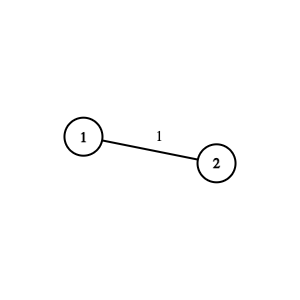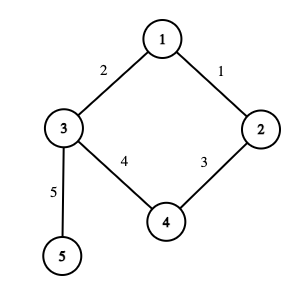309613: CF1706E. Qpwoeirut and Vertices
Memory Limit:256 MB
Time Limit:2 S
Judge Style:Text Compare
Creator:
Submit:0
Solved:0
Description
Qpwoeirut and Vertices
题意翻译
给出 $n$ 个点, $m$ 条边的不带权连通无向图, $q$ 次询问至少要加完编号前多少的边,才能使得 $[l,r]$ 中的所有点两两连通。 翻译者:蒟蒻君HJT题目描述
You are given a connected undirected graph with $ n $ vertices and $ m $ edges. Vertices of the graph are numbered by integers from $ 1 $ to $ n $ and edges of the graph are numbered by integers from $ 1 $ to $ m $ . Your task is to answer $ q $ queries, each consisting of two integers $ l $ and $ r $ . The answer to each query is the smallest non-negative integer $ k $ such that the following condition holds: - For all pairs of integers $ (a, b) $ such that $ l\le a\le b\le r $ , vertices $ a $ and $ b $ are reachable from one another using only the first $ k $ edges (that is, edges $ 1, 2, \ldots, k $ ).输入输出格式
输入格式
The first line contains a single integer $ t $ ( $ 1\le t\le 1000 $ ) — the number of test cases. The first line of each test case contains three integers $ n $ , $ m $ , and $ q $ ( $ 2\le n\le 10^5 $ , $ 1\le m, q\le 2\cdot 10^5 $ ) — the number of vertices, edges, and queries respectively. Each of the next $ m $ lines contains two integers $ u_i $ and $ v_i $ ( $ 1\le u_i, v_i\le n $ ) — ends of the $ i $ -th edge. It is guaranteed that the graph is connected and there are no multiple edges or self-loops. Each of the next $ q $ lines contains two integers $ l $ and $ r $ ( $ 1\le l\le r\le n $ ) — descriptions of the queries. It is guaranteed that that the sum of $ n $ over all test cases does not exceed $ 10^5 $ , the sum of $ m $ over all test cases does not exceed $ 2\cdot 10^5 $ , and the sum of $ q $ over all test cases does not exceed $ 2\cdot 10^5 $ .
输出格式
For each test case, print $ q $ integers — the answers to the queries.
输入输出样例
输入样例 #1
3
2 1 2
1 2
1 1
1 2
5 5 5
1 2
1 3
2 4
3 4
3 5
1 4
3 4
2 2
2 5
3 5
3 2 1
1 3
2 3
1 3输出样例 #1
0 1
3 3 0 5 5
2说明
Graph from the first test case. The integer near the edge is its number.In the first test case, the graph contains $ 2 $ vertices and a single edge connecting vertices $ 1 $ and $ 2 $ . In the first query, $ l=1 $ and $ r=1 $ . It is possible to reach any vertex from itself, so the answer to this query is $ 0 $ . In the second query, $ l=1 $ and $ r=2 $ . Vertices $ 1 $ and $ 2 $ are reachable from one another using only the first edge, through the path $ 1 \longleftrightarrow 2 $ . It is impossible to reach vertex $ 2 $ from vertex $ 1 $ using only the first $ 0 $ edges. So, the answer to this query is $ 1 $ . Graph from the second test case. The integer near the edge is its number.In the second test case, the graph contains $ 5 $ vertices and $ 5 $ edges. In the first query, $ l=1 $ and $ r=4 $ . It is enough to use the first $ 3 $ edges to satisfy the condition from the statement: - Vertices $ 1 $ and $ 2 $ are reachable from one another through the path $ 1 \longleftrightarrow 2 $ (edge $ 1 $ ). - Vertices $ 1 $ and $ 3 $ are reachable from one another through the path $ 1 \longleftrightarrow 3 $ (edge $ 2 $ ). - Vertices $ 1 $ and $ 4 $ are reachable from one another through the path $ 1 \longleftrightarrow 2 \longleftrightarrow 4 $ (edges $ 1 $ and $ 3 $ ). - Vertices $ 2 $ and $ 3 $ are reachable from one another through the path $ 2 \longleftrightarrow 1 \longleftrightarrow 3 $ (edges $ 1 $ and $ 2 $ ). - Vertices $ 2 $ and $ 4 $ are reachable from one another through the path $ 2 \longleftrightarrow 4 $ (edge $ 3 $ ). - Vertices $ 3 $ and $ 4 $ are reachable from one another through the path $ 3 \longleftrightarrow 1 \longleftrightarrow 2 \longleftrightarrow 4 $ (edges $ 2 $ , $ 1 $ , and $ 3 $ ). If we use less than $ 3 $ of the first edges, then the condition won't be satisfied. For example, it is impossible to reach vertex $ 4 $ from vertex $ 1 $ using only the first $ 2 $ edges. So, the answer to this query is $ 3 $ . In the second query, $ l=3 $ and $ r=4 $ . Vertices $ 3 $ and $ 4 $ are reachable from one another through the path $ 3 \longleftrightarrow 1 \longleftrightarrow 2 \longleftrightarrow 4 $ (edges $ 2 $ , $ 1 $ , and $ 3 $ ). If we use any fewer of the first edges, nodes $ 3 $ and $ 4 $ will not be reachable from one another.Input
题意翻译
给出 $n$ 个点, $m$ 条边的不带权连通无向图, $q$ 次询问至少要加完编号前多少的边,才能使得 $[l,r]$ 中的所有点两两连通。 翻译者:蒟蒻君HJTOutput
题目大意:
给定一个由n个顶点和m条边组成的连通无向图,图中顶点编号为1到n,边编号为1到m。需要回答q个查询,每个查询由两个整数l和r组成。每个查询的答案是最小的非负整数k,使得对于所有整数对(a, b),满足l≤a≤b≤r,顶点a和b可以通过仅使用前k条边(即边1, 2, …, k)相互到达。
输入输出数据格式:
输入格式:
- 第一行包含一个整数t(1≤t≤1000),表示测试用例的数量。
- 每个测试用例的第一行包含三个整数n、m和q(2≤n≤10^5,1≤m, q≤2×10^5),分别表示顶点的数量、边的数量和查询的数量。
- 接下来的m行,每行包含两个整数u_i和v_i(1≤u_i, v_i≤n),表示第i条边的两个端点。
- 确保图是连通的,且没有多条边或自环。
- 接下来的q行,每行包含两个整数l和r(1≤l≤r≤n),描述查询。
输出格式:
- 对于每个测试用例,输出q个整数,表示查询的答案。
输入输出样例:
输入样例 #1:
```
3
2 1 2
1 2
1 1
1 2
5 5 5
1 2
1 3
2 4
3 4
3 5
1 4
3 4
2 2
2 5
3 5
3 2 1
1 3
2 3
1 3
```
输出样例 #1:
```
0 1
3 3 0 5 5
2
```题目大意: 给定一个由n个顶点和m条边组成的连通无向图,图中顶点编号为1到n,边编号为1到m。需要回答q个查询,每个查询由两个整数l和r组成。每个查询的答案是最小的非负整数k,使得对于所有整数对(a, b),满足l≤a≤b≤r,顶点a和b可以通过仅使用前k条边(即边1, 2, …, k)相互到达。 输入输出数据格式: 输入格式: - 第一行包含一个整数t(1≤t≤1000),表示测试用例的数量。 - 每个测试用例的第一行包含三个整数n、m和q(2≤n≤10^5,1≤m, q≤2×10^5),分别表示顶点的数量、边的数量和查询的数量。 - 接下来的m行,每行包含两个整数u_i和v_i(1≤u_i, v_i≤n),表示第i条边的两个端点。 - 确保图是连通的,且没有多条边或自环。 - 接下来的q行,每行包含两个整数l和r(1≤l≤r≤n),描述查询。 输出格式: - 对于每个测试用例,输出q个整数,表示查询的答案。 输入输出样例: 输入样例 #1: ``` 3 2 1 2 1 2 1 1 1 2 5 5 5 1 2 1 3 2 4 3 4 3 5 1 4 3 4 2 2 2 5 3 5 3 2 1 1 3 2 3 1 3 ``` 输出样例 #1: ``` 0 1 3 3 0 5 5 2 ```
给定一个由n个顶点和m条边组成的连通无向图,图中顶点编号为1到n,边编号为1到m。需要回答q个查询,每个查询由两个整数l和r组成。每个查询的答案是最小的非负整数k,使得对于所有整数对(a, b),满足l≤a≤b≤r,顶点a和b可以通过仅使用前k条边(即边1, 2, …, k)相互到达。
输入输出数据格式:
输入格式:
- 第一行包含一个整数t(1≤t≤1000),表示测试用例的数量。
- 每个测试用例的第一行包含三个整数n、m和q(2≤n≤10^5,1≤m, q≤2×10^5),分别表示顶点的数量、边的数量和查询的数量。
- 接下来的m行,每行包含两个整数u_i和v_i(1≤u_i, v_i≤n),表示第i条边的两个端点。
- 确保图是连通的,且没有多条边或自环。
- 接下来的q行,每行包含两个整数l和r(1≤l≤r≤n),描述查询。
输出格式:
- 对于每个测试用例,输出q个整数,表示查询的答案。
输入输出样例:
输入样例 #1:
```
3
2 1 2
1 2
1 1
1 2
5 5 5
1 2
1 3
2 4
3 4
3 5
1 4
3 4
2 2
2 5
3 5
3 2 1
1 3
2 3
1 3
```
输出样例 #1:
```
0 1
3 3 0 5 5
2
```题目大意: 给定一个由n个顶点和m条边组成的连通无向图,图中顶点编号为1到n,边编号为1到m。需要回答q个查询,每个查询由两个整数l和r组成。每个查询的答案是最小的非负整数k,使得对于所有整数对(a, b),满足l≤a≤b≤r,顶点a和b可以通过仅使用前k条边(即边1, 2, …, k)相互到达。 输入输出数据格式: 输入格式: - 第一行包含一个整数t(1≤t≤1000),表示测试用例的数量。 - 每个测试用例的第一行包含三个整数n、m和q(2≤n≤10^5,1≤m, q≤2×10^5),分别表示顶点的数量、边的数量和查询的数量。 - 接下来的m行,每行包含两个整数u_i和v_i(1≤u_i, v_i≤n),表示第i条边的两个端点。 - 确保图是连通的,且没有多条边或自环。 - 接下来的q行,每行包含两个整数l和r(1≤l≤r≤n),描述查询。 输出格式: - 对于每个测试用例,输出q个整数,表示查询的答案。 输入输出样例: 输入样例 #1: ``` 3 2 1 2 1 2 1 1 1 2 5 5 5 1 2 1 3 2 4 3 4 3 5 1 4 3 4 2 2 2 5 3 5 3 2 1 1 3 2 3 1 3 ``` 输出样例 #1: ``` 0 1 3 3 0 5 5 2 ```